Publication Information
Frequency: Continuous
Format: PDF and HTML
Versions: Online (Open Access)
Year first Published: 2019
Language: English
| Journal Menu |
| Editorial Board |
| Reviewer Board |
| Articles |
| Open Access |
| Special Issue Proposals |
| Guidelines for Authors |
| Guidelines for Editors |
| Guidelines for Reviewers |
| Membership |
| Fee and Guidelines |
 |
Future Trends and Challenges in Horticulture
Sudip Das*
Department of Biochemistry and Physiology, Bihar Agricultural University (BAU), Sabour, Bhagalpur-813210
Received Date: November 08; Accepted Date: November 21, 2024; Published Date: December 28, 2024;
*Corresponding author: Sudip Das, Department of Biochemistry and Physiology, Bihar Agricultural University (BAU), Sabour, Bhagalpur-813210; Email: spchf12@rediffmail.com
Citation: Das S; (2024) Future Trends and Challenges in Horticulture. Adv Agri Horti and Ento: AAHE-214.
DOI: 10.37722/AAHAE.2024402
Abstract
The future emerging horticultural developing trends solely lies in the recent technological advancement especially protected cultivation, rooftop gardening, vertical farming, precision horticulture, organic farming, hydroponics, aeroponics, home indoor gardening, value addition and food processing etc. The biotechnology, sustainable and organic farming practices, nanotechnology, tissue culture will be the key players in shaping the future of horticulture nationally as well as globally. The climate change is the global concern especially the rise in temperature and drought. The decline in production and productivity in combined drought and heat stress is another big challenge for horticulture scenario which require utmost efficient immediate care. The major challenges are quality planting materials, infrastructure, Pest and disease infestation, poor storage and transportation facility, research and development, marketing strategy and pricing policies, sustainability. The land availability is very critical challenging issue across the globe which is keep on decreasing day by day whereas the demand is increasing every time. So the challenge of the hour is to utilize the every possible free space for vegetable, flower and fruit production in natural or artificial condition available in continuous climate change. Every individual, public, government, NGOs and private institutions and industries may come forward and work together to create awareness in meeting the future challenges in horticulture which are not only environmental but also social and economic.
Keywords: Horticulture, Recent and Future Trends, Challenges, Climate change, Technological advancement
Introduction
Why Horticulture?
- Nutritional Security not Food Security
- Horticulture crops can meet the RDA of fruit and vegetable per capita
- farm income, provide livelihood security and earn foreign exchange.
- Sustainable production
- Quality based not quantity-based production
- Demands for Organically produce products
- Efficient resource utilization -minimum input more output
Objective of this review:
- Present Scenario
- Future Trends of Horticulture
- Technological Advancement and transfer from lab to land
- Interventions in Crop Improvement
- Hi -tech smart Horticulture
- Challenges and solutions
Horticulture is the only option for nutritional security as Horti crops are the source of vitamin, antioxidant, minerals, dietary fiber for vitality and health benefits. Global horticultural production in 2017 was estimated at 1.2 billion tons from over 60 million hectares of cultivated land (Rathore, 2020).
Horticulture sector is recognized to have the potential to raise the farm income, provide livelihood security and earn foreign exchange. The horticulture is very important potential sector of agriculture which is constantly evolving and there is no doubt that the future of horticulture is very bright. In 2022-23, the total horticulture production is estimated to be 351.92 million Ton, surpassing the total food grain production of 329.69 million Ton. At present, India is the second largest producer of vegetables and fruits in the world.
Evolvement of Horticulture: Horticulture has a rich history dating back thousands of years.
Horticulture gained momentum in 17th and 18th centuries, with the development of botanic gardens, the exploration and introduction of new plant species from around the world and the Industrial Revolution in the 18th and 19th centuries brought innovations in horticulture, including the development of new tools and techniques for crop cultivation. Crop breeding and selection also became more systematic. In the 20th century, horticulture got proper advancements in genetics, plant breeding, pest and disease management, and sustainable agriculture practices. The Green Revolution 20th century transformed food production through genetically improved dwarf varieties and technology.
Basic Concepts of Horticulture: Horticulture is the science and practice of cultivating and managing plants, including fruits, vegetables, flowers, and ornamental plants, typically in gardens, orchards, nurseries, and greenhouses. It encompasses various aspects of plant cultivation, such as breeding, propagation, cultivation techniques, and pest and disease management. Horticulture plays a crucial role in providing food, aesthetics, and environmental benefits.
Indian Horticulture Scenario:
Horticulture covers 18% of the net cultivated area.
Horticulture production of 333.25 million MT from an area of 27.5 million ha in 2021-22
India is net exporter of Horticulture produce: Total export-Rs. 45,963.24 Cr
Total Imports: Rs. 37,760.92 Cr
Total Value of Fresh fruits &Vegetables exports was Rs. 12,540.57 Cr
Total Value of Fresh fruits &Vegetables import is of Rs. 18,480.20 Cr
Total export of spices is Rs. 29,273.86 Cr
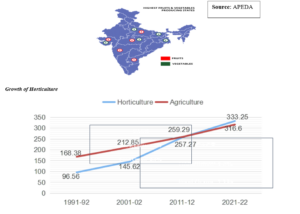
Production of horticulture has surpassed the production of the food grains in India.
In last 7 years, the area under horticulture has increased from 23.4 Million ha to 27.5 Million ha (17.74%) while the production has increased from 280.9 Million MT to 333.25 Million ha (18.63%).
India’s Position at Global Level:
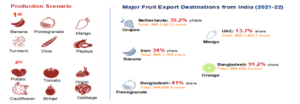
Global scenario and Summary
- The global horticulture industry is valued at $306.2 billion.
- The market value of organic horticulture products is expected to reach $32.06 billion by 2026.
- The global market for ornamental plants is projected to reach $57.4 billion by 2025.
- The indoor horticulture industry is expected to grow by a CAGR of 19.9% from 2020 to 2027.
- The global vertical farming market size is estimated to reach $12.77 billion by 2026.
- The global market for hydroponic vegetables is expected to reach $1.33 billion by 2025.
- The demand for medicinal plants is projected to grow at a CAGR of 7.2% from 2021 to 2028.
- The global market for plant growth regulators is expected to exceed $7.97 billion by 2027.
- The global market for biostimulants in horticulture is projected to reach $5.4 billion by 2027.
- The online gardening market is expected to reach $9.3 billion by 2027.
- The global market for horticulture anti-bird netting is anticipated to grow to $635 million by 2027. The market for horticulture greenhouse shading systems is projected to exceed $6.4 billion by 2025.
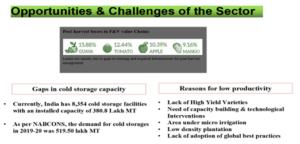
Challenges of the Sector:
- Small scale farming due to size of holdings.
- Inadequate availability of quality planting materials.
- Prevalence of old and senile orchards having low planting density
- Lack of processable varieties for cultivation.
- Low level of mechanization in horticulture.
- Lack of latest technologies for protected cultivation.
- Lack of know-how and do how.
- Lack of sorting, grading and storage facilities
- High initial investment on new orchards
- Climate Change, Water Availibility and Soil Quality
- Sustainable Practices, Technology interventions
- Plant Based Diets,
- Vertical Farming
Sustainable Holistic Approaches : Organic Horticulture:
Changing dietary habits coupled with health consciousness has resulted in growing demand for organic food.
Demand for green food is on increase and harnessing the potential – address soil health, human health and environmental health is considered to have greater significance.
In last few years, organic farming has attracted many farmers across the country especially combined with ecotourism and have experimented successfully.
India is best known as an exporter of organic tea and also has niche market for spices and fruits and vegetables (Parashar et al., 2023). Use of resistant varieties, management of soil vermicompost and biofertilizer and management of disease and pests using biological control as well as bio-pesticides.
Cover Crops: Sun hemp, horse gram in the off season after harvesting a grain or vegetable crop. It is a climate smart crop (Bhandari et al., 2021).
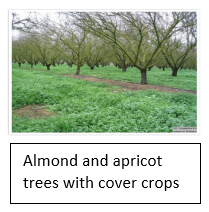
Crop Diversity & Crop Rotation:
It reduces the risks from extremes in weather, market conditions or crop pests.
Increased diversity crops and other plants, such as trees and shrubs, can also contribute to soil conservation, wildlife habitat and increased populations of beneficial insects.
A system that became widely used during the industrial revolution. The practice of rotating difference crops in the same field from year-to-year increased production by improving the fertility of the soil and reducing insects and disease.
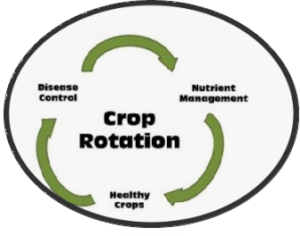 Water: Quality and Conservation: Water quality and conservation have important role in quality production. Many practices viz., deep ploughing, mulching, micro irrigation techniques etc., have been developed to conserve water as well as to protect quality of drinking and surface water.
Water: Quality and Conservation: Water quality and conservation have important role in quality production. Many practices viz., deep ploughing, mulching, micro irrigation techniques etc., have been developed to conserve water as well as to protect quality of drinking and surface water.
Sod mulch: The growing of grasses in entire orchard Tree basins mulched with straw instead of tilling Grasses are mowed down regularly Use of cut over grasses as a mulch in fruit production
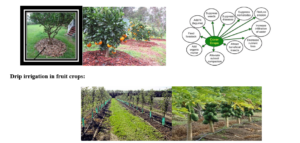
Suitable crops for drip irrigation:
Banana, papaya, citrus, grapes, pomegranate, pineapple, watermelon, citrus
Integrated Pest Management (IPM): IPM is a sustainable approach to managing pests by combining biological, cultural, physical and chemical tools in way that minimizes economic, health and environmental

Future Trends and Technological Advancement in Horticulture:
- Rooftop gardening
- Vertical farming
- Kitchen gardening
- Hydroponics
- Organic horticulture production
- Precision horticulture:
- Guidance System
- Variable rate application
- Crop Sensors
- Weather stations
- Microirrigation system
- Aeroponics
- Biotechnology and tissue culture /CRISPER-CAS9
- Nanotechnology
- Molecular breeding approaches
- Drone technology
- automation, robotics,
- artificial intelligence,
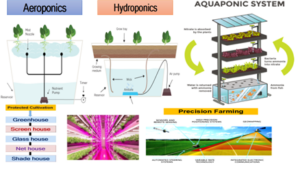 Precision horticulture is an advanced approach to crop production that leverages technology to optimize various aspects of growing plants. This method involves using data and technology to make precise decisions about planting, irrigation, fertilization, and pest control, tailored to the specific needs of each plant or area within a field. (Abdullah et al., 2024).
Precision horticulture is an advanced approach to crop production that leverages technology to optimize various aspects of growing plants. This method involves using data and technology to make precise decisions about planting, irrigation, fertilization, and pest control, tailored to the specific needs of each plant or area within a field. (Abdullah et al., 2024).
Remote Sensing: Using satellite or aerial imagery to monitor crop health, soil conditions, and environmental factors without physical contact.
Soil Mapping: Creating detailed maps of soil properties such as nutrient levels, moisture content, and pH to apply inputs more efficiently.
Variable Rate Technology: Applying fertilizers, water, and pesticides at variable rates based on the specific needs of different areas within a field.
Environmental Control Systems: Managing greenhouse temp., humidity, and light to optimize plant growth.
Automation and Robotics: Utilizing automated systems for tasks like planting, watering, and harvesting to increase efficiency and reduce labor costs.
By integrating these technologies, precision horticulture aims to improve crop yields, reduce waste, and minimize environmental impact. It’s a powerful tool for modern agriculture, helping growers produce more with less.
Protected cultivation
Greenhouse/polyhouse production: Global area under greenhouse cultivation reached over 1 million hectares in 2017, with major expansions in China, India, Turkey and Mexico [Lopez et al., 2017). Innovations in greenhouse cladding involve selective light diffusion, insulation, infrared blocking, anti-condensate films and UV protection to create ideal microclimates Plastics with improved durability, thermal properties, light transmission characteristics, and insulation values are emerging. Green-walls, hydroponics and aquaponics are being integrated into greenhouses for resource use efficiency. However, high infrastructure and operating costs of modern greenhouses pose barriers, especially for smallholder growers in developing regions. Low-cost protected cultivation options tailored for local conditions are essential.
These trends and challenges highlight the dynamic nature of horticulture and the need for continuous adaptation and innovation (Janak Singh Rawal and Puspa Rc, 2024).
Urban gardening and green spaces: Urban gardening and the creation of green spaces in cities continue to be popular trends. People are increasingly interested in small scale gardening, rooftop gardens and community green initiatives. (Hanson et al., 2021).
Indoor gardening and vertical farming: The trend of growing plants indoors and using vertical farming systems has gained momentum. Advances in LED lighting and hydroponic systems have made it easier to grow a variety of plants in limited space.
Sustainable and organic practices: Sustainibility remains a central theme in horticulture. There is a growing emphasis on organic farming methods, reduced chemical inputs, and ecofriendly practices to protect the environment and human health.
Native plants and biodiversity: Gardeners and horticulturists are showing more interest in planting native species to support local ecosystems and biodiversity.
Climate-Resilient Gardening: With the increasing unpredictability of weater patterns due to climate change, gardeners are seeking ways to make their gardens more resilient. This includes selecting drought tolerant plants and using much to conserve soil misture.
Plant based medicine and herbalism:Interest in herbalis and natural remedies has led to a resurgence in growing medicinal and culinary herbs. Many people are creating herb gardens for both therapeutic and culinary purposes.
Houseplants and Biophilic design: The popularity of houseplants continues to rise as people seek to bring principles are being applied to interior spaces to enhance wellbeing and productivity. (Chatakul and Janpathompong, 2022).
Hybrid ad Heirloom Varieties: Disease resistance, higher yield, more ornamental aesthetic varieties are being developed by breeders. Meanwhile, heirloom varieties are being preserved and celebrated for their historical significance and unique qualities.
Technology and Smart Gardening: The integration of technology into gardening practices is growing. Smart gardening tools, apps and sensors are helping gardeners monitor and manage their gardens more efficiently.
In conclusion, we can say that “Horticulture” is dynamic and ever evolving field with a multitude of trends and developments that are shaping the way we interact with plants, gardens and green spaces.
Precision Horticulture and Smart Systems
Precision horticulture aims to enable efficient resource management and enhanced productivity and through data-drive which include precision planting, targeted spraying, automated pruning/harvesting, autonomous robots, variable rate irrigation, drone monitoring, and decision support systems. GPS, GIS mapping, wireless sensor networks, Big Data analytics and the Internet of Things are driving smart precision solutions. Real-time yield monitors using spectral reflectance sensors on harvesters provide intra field crop quality data to refine management practices. Small robot fleets show promise for automated fruit harvesting and picking (Chen et al., 2024). However, wider adoption of these technologies faces barriers like high upfront costs, technical complexity, inadequate rural broadband infrastructure and grower awareness.
- Shade house
- Poly house
- Low tunnels
- Mulching
Precision tools Automation
Automation is solution for solving several challenges. Robotics, for routine repetitive tasks such as planting, crop monitoring, crop protection, plant husbandry and fruit harvesting, will minimize the required labor input to addressing labor shortages in horticultural production. particularly in developed economies. AI tools are to provide crop intelligence, phenology, and pest and disease development, enable precision treatments applied to plants at specific locations wise (Ceccarelli et al., 2022).
One key challenge for developing and marketing automation and/or precision technology is the diverse nature of the aforementioned horticulture enterprise.
Breeding new varieties with precision techniques
Horti based production and management practices for specific genotypes to address challenges of meeting supply chain demand with regard to produce quality, to reduce the length of breeding cycles through speed breeding. Genomic prediction and selection (GPS) are proposed in breeding programmes, may necessitate developing new GPS algorithms, incurring additional cost and delaying breeding programme (Alemu et al., 2024).
Sustainable production practices: Resource use efficiency
Significant challenges include: developing and optimizing management practices to promote soil C-sequestration and reduce GHG emissions in both intensive annual and perennial production systems,
- maintaining or even increasing production and sustainability with reduced input of water and nutrients,
- developing sustainable growing media as alternative to peat;
- exploiting soil microbiome and specific beneficial microbes to increase crop resilience against abiotic and biotic stresses.
Integrated pest and disease management
We need to develop new innovative methods effective pesticide compounds that have less persistence in the environment as well as a lower toxicity to non-target organisms.
There is a growing interest in using beneficial microbes and/or manipulating phytobiome for crop protection in terms of managing specific pathogens or improving plant general resistance/tolerance. There remain, a number of challenges in developing and adopting this phytobiome-based approach for crop protection:
- we need tools with better resolutions to understand the assembly and persistence of phytobiome at specific host tissues/organs and the functions of specific microbial
taxa groups;
- to optimize the use of beneficial microbes, we need the ability to predict their environmental fate post application under the influence of external factors, such as environmental conditions, resident microbiomes and crop husbandry practices (pesticides, fertilizers etc.);
- we need to work with growers and help them to deal with often inconsistent benefits resulting from beneficial microbes due to their nature as living organisms.
Post-harvest management
Presently, shifting toward the consumption of fresh rather than frozen produce is the challenge to develop and refine storage methods to maintain produce premium quality.
Another key challenge in post-harvest technology is to minimize energy usage whilst not compromising produce quality, which is a more engineering issue than biological one (Ogedengbe et al., 2023.)
Year-round supply
Consumers now expect year-round provision of safe, nutritious fruit and vegetables, and cut-flowers which is very challenging (Warrington, 2011). As it needs to understand crop physiology, minimizing energy consumption as well as GHG emission like varying photoperiod or fertilizer regimes to change flowering and hence fruiting can be effective for some fruit crops (Walling and Vaneeckhaute, 2020).
Toward net-zero horticulture
To go ahead with net zero horticulture in order to mitigate climate change risks is become the need of the hour which require need baseline data on the environmental footprint of individual processes in primary production and immediate post-harvest management not only improve crop productivity but also contribute toward net-zero horticulture. Reducing, reusing and repurposing agro-wastes is another key aspect contributing to net-zero horticulture. We have to develop innovations that not only minimize and reuse agrowaste in horticulture but also repurpose agro-waste for crop production as well as food and non-food industrial processes,such as cosmetics, household products, packaging, mechanical, and construction applications. ( Sarkar et al., 2023).
Emerging technologies for post-harvest losses reduction: opportunities and challenges:
Cold Chain and Preservation: The importance of maintaining the cold chain will continue to grow, especially for perishable products like fruits and vegetables. Advanced refrigeration and preservation techniques will extend the shelf life of products.
Traceability and Transparency: Consumers will demand greater transparency in the supply chain. Technologies like blockchain will enable real-time tracking of products from farm to table, ensuring product safety and authenticity.
Sustainability: Post-harvest management will focus on sustainable practices, including the use of eco-friendly packaging materials, reduced energy consumption, and waste reduction through recycling and reuse.
Quality Assurance: Quality control measures will be enhanced with technologies like hyperspectral imaging, which can detect defects and contaminants in products more accurately.
Value Addition: Post-harvest processing will increasingly involve value addition. This includes the production of processed foods, ready to-eat meals, and speciality products to cater to changing consumer preferences.
Small-Scale and Local Processing: Small-scale and local processing facilities will become more common, allowing small farmers and communities to add value to their produce and reduce post-harvest losses.
Drying and Dehydration: Drying and dehydration technologies will advance, enabling the preservation of a wide range of fruits, vegetables, and herbs for longer storage and value-added products.
Food Safety and Sanitation: Strict adherence to food safety standards and sanitation practices will remain paramount to ensure consumer health and compliance with regulations.
Challenges of the sector:
- Climate change-combined drought and heat/global warming
- Land availability
- Quality planting materials/seeds
- Insect,pest and disease infestation
- Poor storage and transportation
- Marketing strategy and pricing policies
- Lack of awareness
Challenges:
Climate Change: Adapting to changing weather patterns and extreme conditions is a significant challenge for horticulturists.
High Energy Costs: The sector faces rising energy costs, which impact profitability.
Labor Shortages: Dependency on migrant labor and the need for skilled workers are ongoing issues.
Biosecurity: Increasing awareness and measures to prevent the spread of pests and diseases due to global trade.
Low Profit Margins: Balancing costs and revenues remain a critical challenge for many in the industry.
What are the solutions in Horticulture?
The future of horticulture is shaped by several emerging trends and challenges. Here are some key points: Protecting resource base and the wider environment. Provide consumers with a variety of products. Expansion of better horticulture crop production. Improved technologies that will augment the global export of quality. Quality is an important aspect of the horticulture industry, whether the horticulture crop is sold locally, regionally or internationally. National and international concern for the sustainable development of horticulture depending on the region.
Climate-Resilient Varieties: Developing crop varieties that can withstand climate change impacts, such as drought and extreme temperatures, is a priority.
Consumer Preferences: Shifting consumer preferences towards healthier, locally-sourced, and sustainably-produced food are influencing horticultural practices.
Innovations in organic farming and Sustainable Practices: There’s a growing emphasis on sustainable horticulture practices, such as organic farming, integrated pest management, and water conservation techniques.
Vertical Farming and Hydroponics as Innovative Practices. Biotechnology and Genetic Engineering in Plant Cultivation: Technological Innovations: Advances in technology, such as automated systems and precision agriculture, are helping to improve efficiency and productivity.
Technological Innovations: Advances in technology, like precision agriculture, drones, and AI, are being used to improve crop yields, monitor plant health, and optimize resource use.
Training and Education: There will be a focus on training and educating post-harvest management professionals to ensure the adoption of best practices and the safe handling of agricultural products.
Global Trade: With the globalization of food markets, post-harvest management will play a critical role in meeting international quality and safety standards for traded products. The rapid growth of the global population, climate change, limited land resources, and biodiversity decline pose new demands and challenges to horticulture. We need to seek innovative solutions to drive horticulture towards a more sustainable direction.
Smart Horticulture: Advances in biotechnology have contributed to a great increase in horticultural yield in the past three decades. However, over the next three decades, the global population is predicted to increase by 2.0 billion, from 8.0 billion in 2022 to 9.7 billion by 2050, with a peak of 10.4 billion during the 2080s, published by United Nations (2022). Moreover, global climate change and other abiotic and biotic factors are having an impact on horticultural productivity, which is expected to worsen in the future (Parajuli et al., 2019).
Conclusion
The future of Horticulture is tremendous bright by innovation, sustainability, and a response to the changing demands of a growing global population in continuous climate change condition. The future demand is to produce high-quality fruit while addressing environmental and sustainability concerns, will play a pivotal role in providing nutritious and diverse vegetables to meet the demands of a growing global population, to involve a blend of tradition and innovation, with sustainability, technology, and changing consumer preferences will continue to provide beauty, aesthetics, and emotional. Sustainability, climate resilience, and meeting changing consumer preferences will be central to the evolution of the horti-based industry. Future of aromatic plant cultivation will involve a focus on sustainable natural and fragrant products. These developments will help meet the challenges of feeding a growing global population while minimizing the environmental footprint of food production.
Interpretation: Green is the new gold. Globally horticulture seems to sprout extensively indoor horticulture approx. 20% growth rate or the blossoming market for biodegradable pots, here, every seed sown today promises a bountiful harvest for tomorrow. The statistics seems the horticulture industry is not just about pretty flowers and perfectly manicured lawns—it’s a blooming business with serious economic clout. From providing livelihoods for hundreds of thousands of individuals across the world.
Reference
- Alemu, A., Åstrand, J., Montesinos-López, O.A, Isidro, Y., Sánchez. J., Fernández-Gónzalez, J., Tadesse, W., Vetukuri, R.R., Carlsson, A.S., Ceplitis, A., Crossa, J., Ortiz, R., Chawade, A. 2024. Genomic selection in plant breeding: Key factors shaping two decades of progress. Molecular Plant 17(4): 552-578. doi: 10.1016/j.molp.2024.03.007.
- Bhandari, R., Shivakumar, K.V., Kar, C.S., Bera, A., Meena, J.K. 2021. Sunn Hemp: A Climate-Smart Crop. In book: Developing Climate Resilient Grain and Forage Legumes. Pp. 277-294. DOI: 10.1007/978-981-16-9848-4_13
- Ceccarelli, T., Chauhan, A., Rambaldi, G., Kumar, I., Cappello, C., Janssen, S., McCampbell, M. 2022. Leveraging automation and digitalization for precision agriculture: Evidence from the case studies.Background paper for The State of Food and Agriculture 2022. FAO Agricultural Development Economics Technical Study, No. 24. Rome, FAO. https://doi.org/10.4060/cc2912en
- Chatakul, P., Janpathompong, S. 2022. Interior plants: Trends, species, and their benefits. Building and Environment 222: 109-325
- Chen, Z., Lei, X., Yuan, Q., Qi, Y., Ma, Z., Qian, S., Lyu, X. 2024. Key Technologies for Autonomous Fruit- and Vegetable-Picking Robots: A Review. Agronomy 14(10): 22-33. https://doi.org/10.3390/agronomy14102233
- Abdullah, H.M.,Islam, M.N., Saikat, M.H., Bhuiyan, M. A. 2024. Precision agriculture practices from planting to postharvest: scopes, opportunities, and challenges of innovation in developing countries. Remote Sensing in Precision Agriculture, 3-26.
- Hanson, H.I, Eckberg, E., Widenberg, M., Olsson, J.A. 2021. Urban Forestry & Urban Greening 63:127198.
- Rawal, S., Puspa, R.C. 2024. Integrating Aquaculture And Hydroponics: A Review Of Aquaponics Systems And Their Sustainability. Engineering Heritage Journal (GWK) 5(2): 53-61.
- Lopez Cruz IL, Lopez Vazquez A, Marques dos Santos F, Ortega Rubio A, Suarez Balcazar CY, Ochoa Martinez CI, Franco Mora O. 2017. Automated Monitoring System for a Tomato Hydroponic Greenhouse. International Journal of Advanced Computer Science and Applications. 8(2).
- Parashar, S., Singh, S., Sood, G. 2023. Examining the role of health consciousness, environmental awareness and intention on purchase of organic food: A moderated model of attitude. Journal of Cleaner Production 386(1):135553
- Parajuli, R. Thoma, G., Matlock M. 2019. Environmental sustainability of fruit and vegetable production supply chains in the face of climate change: a review. Science of the Total Environment650(2): 2863-2879
- Rathore M.M. 2020. Technological interventions in horticulture. In Technological Innovations in Major World Oil Crops. Springer, Cham.1:319-346.
- Sarker, M.N.I., Hossain, B., Shi, G., Firdaus, 2023.Promoting net-zero economy through climate-smart agriculture: transition towards sustainability. Sustain Sci 18: 2107–2119. https://doi.org/10.1007/s11625-023-01379-0
- Ogedengbe,T., Olorunfemi, M., Elizabeth, A.N. 2023. Post-Harvest Losses and Reduction Techniques in Crop Production: A Review. The Journal of Agricultural Education and Extension 12(4): 225-223.
- Walling, E., Vaneeckhaute, C. 2020. Greenhouse gas emissions from inorganic and organic fertilizer production and use: A review of emission factors and their variability Journal of Environmental Management 276: 111-211
- Warrington, J. 2011. Challenges and Opportunities for Horticulture and Priorities for Horticultural Research at the start of the Twenty-First Century. Acta Horticulturae 916: 59-68. DOI: 10.17660/ActaHortic.2011.916.6